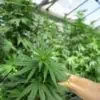TABLE OF CONTENTS
Cannabis exhibits remarkable resilience as a plant, but even experienced enthusiasts may face occasional challenges during their cultivation endeavors.
Fortunately, if caught early enough you can make some changes to your cultivation practices that will put plants on the road to recovery, and soon the problem will be just a memory.
One of the easiest ways to identify cannabis health problems is by examining the leaves on a daily basis.
Cannabis leaves can tell a lot about the plant, from its genetics to its overall health and vigor.
Leaf Structure and Genetics
Even if you don’t know a plant’s exact strain, leaf structure can usually give you some ideas about its genetic background.
Although pure sativa and indica plants are less common in United States cannabis cultivation and hybrids are the most common plants encountered, most of them will have an appearance that learns to either sativa or indica genetics.
Some unstable hybrid strains will have a variety of phenotypes that vary significantly from one another, regardless of the fact that they share the same family tree.
The effects of these phenos can also vary, with some being more like indica and others being more like sativa. Plant and leaf structure will tell you a lot about what to expect.
Generally speaking, sativa plants grow taller, with a lankier plant structure. The leaves of sativa plants are slender and long, and the overall color is often a lighter shade of green than indica and hybrid plants.
Indica plants are quite different. The plant structure is short and squatty compared to sativa. Their leaves are much wider, and the color is darker. The leaf shape and color are good at absorbing the maximum amount of the sun’s rays.
Hybrids, as you might guess, fall somewhere between the two. Many hybrid plants have medium height and leaves with moderate thickness.
There are always an odd number of leaves on the hands of cannabis plants, with a higher number of leaves on sativa plants than indica or most hybrids. Five, seven, and nine leaves are the most common numbers seen.
Leaf Condition as a Sign of Overall Health
The shape and color of a cannabis plant will tell the grower quite a bit about the plant’s health as well as how good of a job the grower is doing tending to his or her garden.
Often, the condition of a marijuana plant’s leaves can provide telltale signs about what the grower is doing wrong or can improve on.
Let’s take a look at some of the most common leaf abnormalities and what they may indicate about the plant’s overall health and care.
Yellow Leaf Tips

Examine the very tips of your cannabis plant’s leaves carefully each day during both the vegetative and flowering stages of its life. Sometimes yellow leaf tips can be subtle and easy to overlook.
In more severe cases, the leaves tips may even be slightly curled, as well as yellow. This often is a sign of minor nitrogen burn from slightly overzealous feeding.
Nutrient burn is a common problem for beginning growers who assume more nutrients are better for the plant and it will grow stronger as the result of a vigorous feeding schedule. These growers need to change their practices and follow more of a “less is more” philosophy.
Never feed a cannabis plant an inexact amount of nutrients. The best practice is to read the label’s feeding schedule and then reduce the dose slightly.
Add soil amendments to your water every other feeding rather than each time you water the plants. After adjusting your nutrient dosage, carefully evaluate new leaves that form. Most likely, they will not have burned tips.
Drooping Leaves
Overwatering or underwatering a cannabis plant are two of the most common mistakes made by beginner cannabis growers—particularly overwatering.
Drooping leaves are usually a sign of underwatering the plants. Plants that are underwatered will also grow slower and lack a vibrant, healthy look.
Fortunately, the solution to this problem is simple. Water the plants! Plants should receive enough water so that approximately 25 percent of the water drains from the pots, indicating that the root systems have received a thorough soaking.
If the soil is dry even an inch or so under the surface and the leaves are drooping, the plants need more water. After a thorough soaking, you should see the plants perk up within a couple of hours.
Curled Leaves
Leaves that hang and have some curling or cupping as well usually are showing signs of being overwatered. This is a particularly common problem with beginner cultivators.
Once again, the “more is better” philosophy rears its ugly head, and “less is more” practices need take place immediately. Back off on the water immediately.
The plants will need to dry out, and it may take a few days to accomplish this. Cannabis watering needs can vary due to a variety of factors such as how hot and humid the grow area is and the type of pots used.
Reduce the amount of water provided and water less often. Water until approximately 25 percent of the water drains from the pots.
Depending on your heat and humidity, you may only need to water every 2-3 days. The soil surface should be dry, with moisture still evident about an inch under the surface.
Yellow and Brown Blotches on Leaves

This is a sign of more severe nutrient burn than just burned leaf tips. Blotches on leaves are usually—but not always—a sign of overfeeding.
This can be a common occurrence with growers who feed a good organic nutrient diet and also start out with growing plants or transplanting them into organic pre-loaded soil.
Many good organic soil mixes have organic nutes already in the mix, so there is no need to supplement the plants with additional nutrients until the nutrients present are flushed from the soil.
Again, read the recommended dosage and back off a little, reducing the amount that you provide. The blotchy leaves will remain scarred, but after some feeding adjustments, the new leaves should be a universal green color.
White Spots on Leaves
This is an obvious sign of white powdery mildew, and it occurs from a growing area that is too humid.
An outbreak of white powdery mildew is enough to make any cultivator’s heart sink, but there are things he or she can do to address the problem.
The real solution, however, and the way to prevent a recurring problem is to lower the grow area’s humidity with increased ventilation and air flow with fans. A number of home remedies for white powdery mildew work quite well.
However, the most effective method is to wipe the mildew from the leaves with tap water on wetted paper towels or hand cloths. Then, dry the leaves and run an oscillating fan or two stationary fans in the room, and ensure the room has proper ventilation (a lack of ventilation and air circulation is most likely the original cause of the problem).
Finally, mix a solution of SM-90 and water at a ratio of 1 part SM-90 to 5 parts water. Then use a clean spray bottle to thoroughly mist your plants shortly before the lights go off.
Be sure to spray all areas of the leaves and plant. This solution is safe to use at all stages of plant growth, even flowering.
Webby Appearance to Leaves
Often, the appearance of a webby substance on plants occurs on the flowers rather than the leaves. This is a clear sign of mold.
Mold is a fairly common problem with cannabis plants, especially indoors or in a greenhouse setting, where humidity levels can get high and air circulation is low. Mold is devastating but more easily prevented than some other cannabis cultivation problems.
Mold will kill plants and ruin flowers, so its impact on a grow can be severe. Unfortunately, it often reveals itself well into the flowering stage, when small, yellow leaves appear on the buds.
The yellow leaves are a sign that mold is occurring at their base, within the interior nooks and crannies of the flowers where moisture can hide and get a foothold. Left unchecked, mold will quickly destroy the entire bud and spread to other areas of the plant.
If you detect mold—often found on the biggest, densest, and best buds—clip the bud from the plant immediately and remove the plant from the grow.
Damaged Leaves
Damage to the leaves is usually a sign of a pest problem. Spider mites are the most likely culprit, and once they are present, they can be difficult to eradicate.
Spider mites, like other insect pests will gnaw small holes in the leaf surface and suck the juices to sustain themselves. To effectively treat a spider mite infestation, it’s important to detect them early.
Inspect your plants’ leaves, especially the undersides, on a regular basis. Maintain good air circulation in your grow room. Not only do the plants benefits from it, but spider mites don’t like the breeze.
Spraying the plants thoroughly with any of a variety of products like Azamax or Mighty Wash will go a long way toward exterminating spider mites or keeping them in check. After spraying your plants shortly before the lights go off, keep fans circulating air in the room.
Some growers have luck eradicating spider mites by using Neem Oil following treatment with the products mentioned above. Before starting another crop in the grow space, thoroughly eradicate the mites with repeat treatments of a safe pesticide.
Once you are certain they are gone, proceed with your next grow. Don’t be surprised if they return. Spider mites are very resilient and a real pain.
“
There are over 300,000 jobs in the cannabis industry. CTU trained me for one of them!

Makes $24.50 @ THC +
Deformed Leaves
Deformed cannabis leaves are not an uncommon occurrence with cannabis plants. There can be a variety of causes, and usually they are not a sign of a serious problem.
Leaf deformities commonly occur on young plants. Short leaves in the middle of leaf hands or even numbers of fingers on the hands are two of the common deformities.
As young plants with deformities grow, the adult leaves usually take on the standard appearance you like to see on healthy plants. Deformed leaves can also have genetic causes, particularly on inbred strains.
Some strains are known for deformities more than others. Although Blueberry is a great strain for its pleasing colors and effects, those who have grown it a few times have most likely noticed odd plant structure and misshapen leaves.
The flowers themselves usually appear very normal. Deformed leaves due to genetics is not always something to be overly concerned about it the plants are healthy otherwise.
Learning to closely examine your cannabis leaves as a standard procedure is a wise practice that should occur whenever growers tend to their gardens.
You can learn some valuable lessons by identifying leaf abnormalities. Address them early is the best way to enjoy continued success with your cannabis plants to ensure a bountiful crop.
Learn to grow weed and more about cannabis diseases and pest issues by enrolling in Cannabis Training University!

Luis Cordova
Luis Cordova is a distinguished author, and renowned expert in cannabis cultivation, who possesses a Master's degree in Plant Biotechnology and Pharmaceutical Science. As a valued contributor to highly esteemed publications such as Cannabis Training University and Maximum Yield Magazine, Luis has emerged as a trusted source of guidance and knowledge in the cannabis industry. Having written thousands of informative articles, Luis is widely recognized for his comprehensive expertise on cultivating cannabis, both indoors and outdoors.












 Jeff was involved in an accident where he endured a traumatic brain injury. He had a week-long stay in ICU where brain surgeons
Jeff was involved in an accident where he endured a traumatic brain injury. He had a week-long stay in ICU where brain surgeons  100% risk free money back guarantee within 48 hours after purchase if student has not completed any of the courses or exams.
100% risk free money back guarantee within 48 hours after purchase if student has not completed any of the courses or exams.